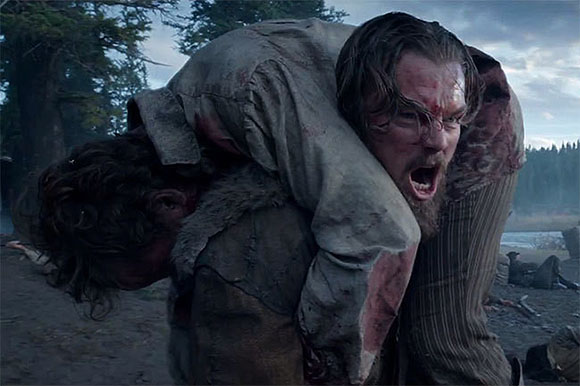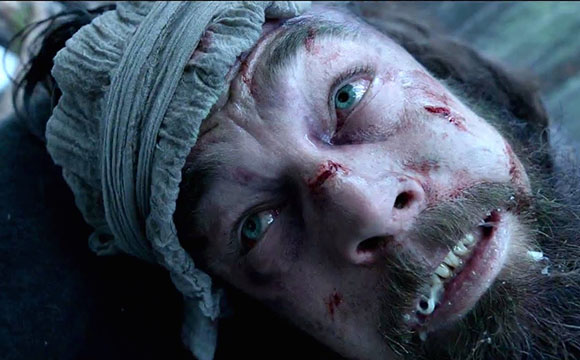
The Revenant is difficult. It’s difficult to watch. Difficult to understand the dialogue. And the whole marketing narrative about the film’s intentionally difficult production has tainted the final product. All of this compounded intentional difficulty makes its an exceptionally difficult film to critique. I can’t properly untangle the art itself from awards season, the artists, and the very silly things they’ve said about the film. The Revenant is fresh off the bottling line, and like any wine with potential, it needs to age in a dark cellar somewhere.
Of course there’s no telling whether it’ll be better received after the hype has died down, but that’s the best shot it has at being something that lasts. Because right now, the film might as well be about an ice-bearded Leonardo DiCaprio being mercilessly pursued across the frozen wilderness by a paparazzo with a steadicam.
DiCaprio plays Hugh Glass, an American fur trapper working the frontier with his half-native son, Hawk (Forrest Goodluck). When Glass is mauled by a grizzly for like a half hour, his boss (Domnhall Gleeson) decides to leave him in the woods, under the care of Fitzgerald (a mushmouthed Tom Hardy) and Bridger (Will Poulter). That arrangement doesn’t last, and Glass is buried alive by Fitzgerald, who escapes with Bridger. Miraculously, Glass fights infection and injury and starts to crawl his way toward revenge.
Shot almost entirely in low angles, The Revenant is a fascinatingly ugly film. The big attack on the trapper camp in the film’s first act actually made me nauseous, and not because it was too gory or intense. It was because the long steadicam shots never stop roving and whirling — never settling on a well-composed frame. It’s like Terrence Malick went on a booze n’ coke bender and decided to challenge the gods. That sounds a lot more fun that it actually is, but you get the idea. The film eventually settles into a firmer groove. The haunting winter vistas and natural lighting are frequently beautiful, especially at night, but the film is over-reliant on hollow visual motifs and tedium. There are only so many low angle shots of snowy trees you can look at before you can only roll your eyes.

Not to be outdone by the film’s ugly-pretty aesthetic, DiCaprio grunts, wheezes, and drips his way from one grossout scene to the next. His performance is undeniably visceral and his stunts are certainly daring, but the fact that DiCaprio is one of our biggest movie stars doesn’t work in the film’s favor. Is there some sadistic glee in watching a rich, handsome man gnaw the guts out of a wriggling fish? Maybe, but it adds a layer of unremovable artifice to the film. Case in point: when a lone native hunter offers Glass a chunk of raw bison liver, the scene plays out like a game of “who can eat this real raw bison liver with more INTENSITY, BRO?”. It’s silly. But again, that artifice might be worn down with time. We might be able extract the character from the actor, but considering this whole unfortunate “Leo wants the Oscar!” narrative we’ve imposed on him, that can’t properly happen.
The effect of all this manufactured misery, combined with a very particular and jarring aesthetic, is that The Revenant does not capture the feeling of being Hugh Glass. It captures the feeling of being a camera that is photographing Hugh Glass. Was that the intention? It doesn’t matter. But somewhere, deep in in this film is the potential for it to work on its own terms, as a piece of extreme cinema. I just don’t think it can right now.
Travis’s Rating:

2.5 Raw Bison Livers out of 5